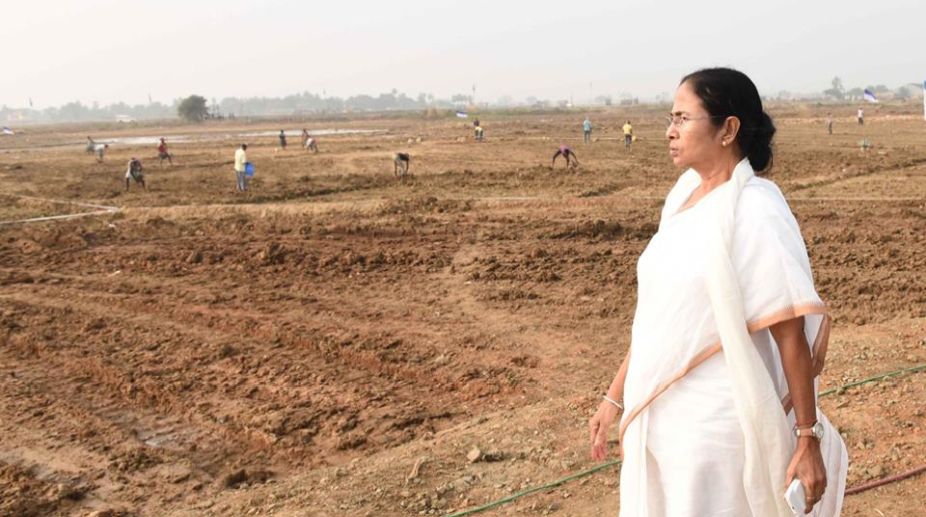Both the media and civil society have been rather muted in their response to the historic Supreme Court judgment of 31 August 2016. It had ordered the West Bengal government to return the 400 acres of fertile and disputed land to the farmers in Singur. The land had been acquired by the Left Front government to enable Tata Motors to set up the Nano factory. Are the farmers really cultivating the land which was virtually transformed into non-agricultural wasteland after the takeover? What happened to those farmers who were subsisting on the absentee landowners’ land within the 400 acres? What about the recorded and unrecorded sharecroppers who were cultivating 2-3 crops in a season in the area that was supposed to be returned by the order of the apex court? No one seems to be interested in the ground realities of Singur now… after a decade of turbulence in 2006-07. This indifference towards the peasantry is not a new phenomenon among the Kolkata-based academics and intellectuals.
There are of course certain exceptions. In 2016, a four-member team representing “Women Against Sexual Violence and State Repression, West Bengal”, comprising Nisha Biswas, Swapna Bandopadhyay, Sharmishtha Choudhury and Swapna Gayen, had visited Singur. It observed that the place was a “perfect example of purchasing dissent” and the report was published in Frontier on 18 April 2016. I quote from the concluding part of the report:
Advertisement
“Perhaps the saddest feature of Singur today is the retrogression of women. Shyamali, Tapasi, Krishna were not only valiant warriors; they were also mass leaders a mere 9-10 years ago. Today they have humbly, silently and without resistance returned to hearth and home, content with the government’s dole and their role in housekeeping. Their public lives are now a distant memory and private chores fully make up their present. This casual dismissal of women from the political space and public domain is even more ironic under the chief ministership of a notoriously firebrand woman”.
During 1994-2005, I pursued my doctoral research based on anthropological fieldwork supplemented by reference work in the archives of the land acquisition department. Landless agricultural workers, small landowning peasants and sharecroppers are predominant in West Bengal. Land reforms and the panchayati raj system are pivotal in the overall construct. I had made the point in my first article on land acquisition, which was published in The Statesman in April 1998.
My field area was Kharagpur I block in Midnapore district. Large-scale acquisition of farmland for the Tatas took place in the early 1990s with very poor rates of compensation (Rs 20,000 per acre). The farmers also resisted land acquisition and finally a large tract of land acquired for a Birla Group remained unutilised for several years. But virtually nobody (Mamata Banerjee, Mahasweta Devi and Medha Patkar included) raised their voice against this acquisition. I compared this incident at a much later period of my research with the happenings at Singur in 2006 in an article entitled ‘Singur on the Kharagpur track’, published in this newspaper in December 2006. In all respects, there were sufficient reasons for Kharagpur to gain national and international recognition like Singur. But it did not happen. There were several reasons behind the silence of Kolkata-based intellectuals and the then Opposition parties over the land acquisition for the Tatas and Birlas by the Left Front government in Kharagpur in the early 1990s.
First, anti-Left political parties and human rights groups were not much interested in the land acquisition issue during that period when the Left Frontdriven industrialisation was at its nascent stage. The government had promised huge industrial investments by private companies in the state. Second, though the farmland acquired in Kharagpur provided food security to vegetable growers of a place called Gokulpur, the land was mono-crop in nature. A common refrain was that mono-crop land might be acquired since we need to have industrialisation in the state, but multi-crop land should never be allowed to be acquired for non-agricultural purposes.
There was hardly anybody in the anti-Left Front lobby who demanded the upgradation of the land from mono-crop to multi-crop, which should have been the government’s policy. The anti-acquisition lobby wondered why the government was not setting up industries in the arid belt of Purulia, Bankura and West Midnapore. It was argued that if industries came up in these backward districts, the poor would have benefited.
Third, despite the spontaneous but feeble protests and resistance by farmers of Kharagpur during the mid- 1990s, no Opposition party lent solid support, as they had done in the case of Singur.The media did report the adverse effects of acquisition and the protests of farmers, but these did not attract the attention of Kolkata-based intellectuals and human rights groups. They were at that time obsessed with other issues.
The scenario changed after the massive resistance of the farmers against land acquisition in Singur and Nandigram during 2006-8. Economists, including Amartya Sen, and social activists, notably Medha Patkar, and politicians wrote and spoke on the justification of land acquisition for private industries in West Bengal. Websites named sanhati.com and counterviews.com were launched. Development resulted in forced displacement and resettlement in Communistruled West Bengal.
Out of this plethora of literature, I have made an attempt to find out the major arguments which justified the land takeover for industries in West Bengal, which till the other day was a state noted for the implementation of pro-farmer land reforms and decentralized rural development. During the early 1990s, the Left Front leaders argued that since land reforms had raised agricultural production and the purchasing capacity of the peasantry, the state is the ideal ground for the establishment of capital intensive heavy and medium industries. The second line of argument was advanced by the more theoretical Marxists who claimed that industries would be able to absorb the extra labour force engaged in agriculture in a disguised form and also owing to the introduction of mechanisation in cultivation. The proponents of this line of argument also stated that agriculture, owing to land fragmentation caused by inheritance of property rights and the hike in input costs, had ceased to be viable for many small and marginal farmers. This argument may be termed as “employment through-industrialisation”.
The land reforms introduced by the CPI-M resulted in patta holders being given small plots. These arguments were not supported by any empirical data either by the government or by any independent researcher. On the contrary, the two substantial government reports, one prepared by Nirmal Mukarji and Debabrata Bandopadhayay in 1993 and the other by Jayati Ghosh in 2004 showed with data collected from government sources that land reform and registration of sharecroppers still remained incomplete. Landlessness was on the increase in West Bengal. The reports suggested better land reforms and formation of active cooperatives as well as more government responsibilities towards the creation of improved marketing facilities for the rural cultivators. The empirical findings of the government’s own reports by experts were largely ignored by the administration and huge investments for capital intensive industrialisation were encouraged and justified by macroeconomic arguments. My empirical findings also showed that land reform could be pushed back by land acquisition by dispossessing the patta holders as well as sharecroppers.
(To be concluded)











